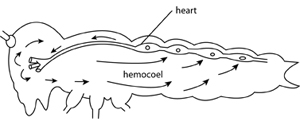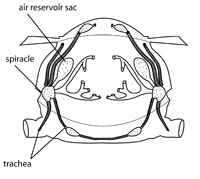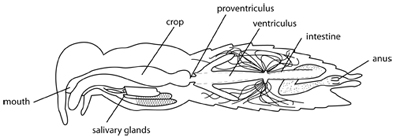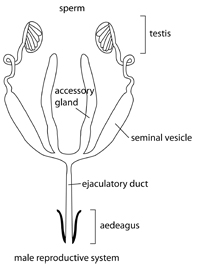|
Circulatory System
Insects possess an "open" circulatory system in which an insect's blood (hemolymph) fills its body (hemocoel) rather than being contained within vessels (closed systems) as in most higher animals. Hemolymph comprises up to 40 percent of an insect's body weight. The only vessel that most insects possess is called an aorta, or sometimes simply referred to as a heart. This long tube lies dorsally inside the insect and serves as a pumping chamber. The insect blood enters through small holes in the aorta and then is pumped forward as the vessel contracts and is dumped into the insect body homocoel again. In this way, hemolymph sloshes around in the insect body and reaches all necessary tissues. Insect blood is clear in color rather than red, because it does not have need for red blood cells to transfer oxygen.
Respiratory System
Oxygen reaches internal tissues by means of tiny tubes (invaginations) of the exoskeleton. The outer holes along the insect's body, called spiracles, allow air to diffuse into the small tracheal tubes, which further branch into progressively smaller tubes that eventually enter into the muscles, internal organs, and tissues of the insect. In this manner, insects are able to get the necessary oxygen to cells for respiration.
Digestive System
Insects ingest food through one of the several kinds of mouthparts described earlier. Solid or liquid food is taken in through the mouth leading into a complete alimentary food canal. Food is broken down by enzymatic hydrolysis and is absorbed through the gut wall and into the insect. Undigested material is excreted through the anus at the rear of the alimentary canal.
Reproductive System
Insect reproduction is almost always sexual (requiring a male and a female) but in a few cases it may be asexual (requiring a female only). Some insects use both. In sexual reproduction, the males copulate with the females, sending sperm into the egg chamber of the female. Eggs there are fertilized and then pass out of the oviduct and are usually deposited either singly or in clusters in the environment.
Nervous System
Individual insect nerve cells are constructed much like vertebrate nerves. A sensory structure, such as an eye or antennae, triggers a nerve impulse that travels along the length of the nerve cell. This nerve ends in close contact with other nerves in a junction called a synapse. Specific chemicals are released in this junction and if adequate amounts are picked up by the second nerve, the impulse will again be carried to yet other nerves or to muscle tissue, causing them to contract or expand. Many common insecticides work by disrupting the communication process at this junction.
The nervous system in insects consists of a long nerve cord made up of many nerves bundled together. This cord lays ventral in the insect body and runs the length of the insect. Several nerve masses form a primitive brain toward the anterior end of the nerve cord but, unlike verterates, the central insect nervous system also has smaller centers along the nerve cord in the thorax and even the abdomen. These smaller masses spread along the nerve cord help direct coordinated processes such as reproduction, movement and other life supporting functions, independent of the larger brain in the head area. This is why cutting the head off of an insect often does not stop it from walking or mating.
|








